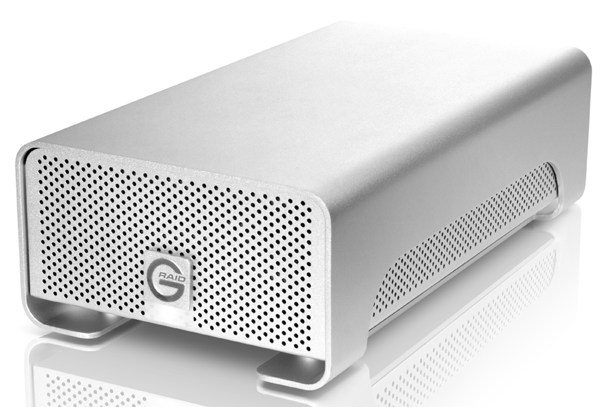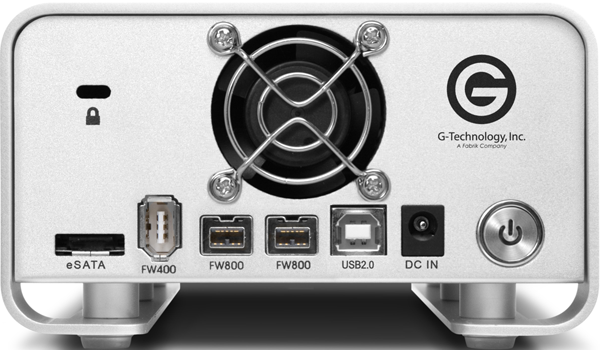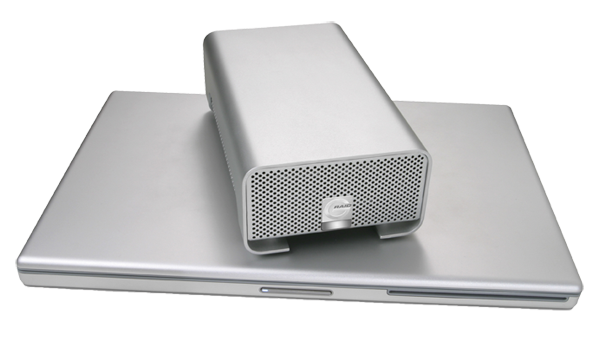G-Raid 3 Quad Interface Dual-Drive RAID 0 Array
Company: G-Technology, Inc.
Price: 2 TB model $499 3 TB model $649
http://www.g-technology.com/Products/g-raid3.cfm
 Â
Â
Digital images, video and audio files are like the creature from Star Trek, consuming every free gigabyte it encounters. While consumer-level internal hard drive capacities have crossed the 2 TB barrier, many users need even more storage space, and they need it to be portable.
G-Tech’s G-RAID3 is one solution. MyMac Labs used it for several weeks; here are our impressions.
Before diving into the G-RAID3, a quick explanation of RAID 0 is in order.
If you didn’t wade through the entire article, there are a few take-away points about RAID 0:
1) RAID 0 provides no data redundancy.
2) RAID 0 is normally used to increase performance.
Why would one want to use a RAID 0 array? In my opinion, the driving reason to use a RAID 0 is that you have a single very large “logical” disk. The G-RAID3 appears as one disk (2 or 3 TB depending on the model), and you won’t have to deal with having to split your large data files across multiple disks. You may not see the “this disk is almost full” message during your natural lifetime!
$499 seems pricey for two hard drives in a nice aluminum case. What does the G-RAID3 provide for your heard-earned money?
• Quad interface eSATA, FireWire 400, FireWire 800, and USB 2.0. The G-RAID3 is capable of over 200 MB/second transfer rates when connected to any Mac or PC via eSATA. G-Tech notes that only FireWire 400 is supported in Mac OS 9.
• “Smart†fan for long life and reliable, nearly silent operation.
• The latest generation Oxford 936 chipset.
• (2) 7200 RPM SATA II drives each with up to 32MB cache.

To call the case “nice” is an understatement. You get your money’s worth with this enclosure. It’s a solid, nay, a heavy aluminum case that provides great protection for your valuable bits and bytes within. No cheap plastic substitutes here; the aluminum has a great finish to it. Â Even the power button has a satisfying “click” when depressed, and it flashes during disk activity, as well.
The Lab was pleased that G-Tech includes a one meter long cable for every port; FireWire 400, FreWire 800, USB 2.0, and eSATA. You won’t need to buy a cable after buying the G-RAID3, unless one meter is too short for your needs.
Alas, the G-RAID3 has an external power supply. I suspect there’s no easy way to use an internal power supply without the case getting hotter and more crowded.
If you’ve never used a large RAID array before, you don’t know how pleasing it is to find a vast expanse of virgin disk space awaiting you when you start the drive for the first time. The G-RAID3 popped up on the Desktop, and a Get Info showed 1.82 terabytes available. Ahhh, so much space for so many files. At this point, I waxed nostalgic, and I felt compelled to dig out my sole remaining 400K floppy disk, and gaze lovingly at it. Macintosh personal computers have progressed from 400K floppies to affordable multi-terabyte RAIDs in just over 25 years.

Once connected, there’s little to do wrong. If you have questions, G-Tech has a comprehensive FAQ online.
To load data on the G-RAID3, I used Carbon Copy Cloner 3.2 to clone my 1 TB boot drive to the G-RAID3. FireWire 400 pushed the data from the internal to the G-RAID3 at roughly 20 MB/second, depending on the size of the files being copied. I saw peak speeds if 35 MB/sec, as I watched the copy progress using Activity Monitor. Larger file chunks transfer more quickly than do smaller chunks. I regret that my Mac Pro has no eSATA card; eSATA is probably the fastest interface available for Macs. The G-RAID3 was nearly silent in operation, with the drive read/write sounds barely perceptible beneath the soft hum of the fan. We’re noise-sensitive, so the quiet operation of the G-RAID3 is a major plus.
I used the G-RAID3 as a backup device for several weeks. It performed its backup responsibilities very quickly, with no muss, no fuss.
As noted above, your data’s security in a RAID 0 array depends on both drives operating normally. If one drive kicks the proverbial (bit)bucket, your array is gone, and so is your data. The G-RAID3 comes with a three-year factory warranty, so the hardware is covered, but there’s no way to get a warranty replacement for your data. My opinion is that the risks of using RAID 0 are not as significant for a backup device as for primary boot drive. Backup drives are used for backup, and that means restoring data when needed. If you elect to employ the G-RAID3 as a primary boot or storage drive, make sure you maintain good backups, and use tools such as Alsoft’s Disk Warrior to keep the directory in top shape. Unfortunately, both Disk Warrior and Apple’s Disk Utility could not check the SMART status of the array (“unsupported”), so it appears this useful tool for monitoring hard drives can’t be used with a RAID 0.
Speaking personally, I have run a Mac Pro from a RAID 0 array for close to a year, with no troubles. Granted, that’s a short time, statistically speaking, but my experience with RAID 0 has been good. I keep comprehensive backups, and check the drives with Disk Warrior once a month, at a minimum.

Pros:
The G-RAID3 is a fine, high-capacity RAID 0 array. The case is one of the best I’ve ever seen. The G-RAID3 Â comes with a full set of cables. The hardware has a three-year warranty. Performance is very good.
Cons:
RAID 0 depends on both drives working; this additional risk may not be acceptable to some users. The G-RAID3 is expensive.
Conclusion:
The G-RAID3 is a classic example of paying a higher price for a top-of-the-line device. You can find cheaper, but you won’t find better.
email – MyMac Magazine – Twitter – Advertise – Reviews Archive – Podcast

Leave a Reply
You must be logged in to post a comment.